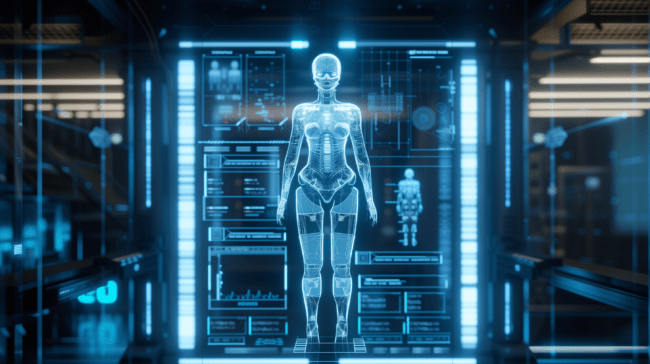The Intersection of AI and Medical Imaging
AI has been reshaping numerous industries, but perhaps nowhere are its implications more promising than in the field of medical imaging. The ability to process large datasets quickly and identify patterns undetectable to the human eye makes AI a game-changer in diagnosing and treating health conditions.
Diagnosing Diseases
In the realm of diagnosis, AI has already demonstrated a significant impact. The technology’s precision and speed are revolutionizing how medical professionals detect diseases.
Pattern Recognition
Machine learning algorithms excel at pattern recognition, a crucial task in medical imaging. By training these algorithms with vast databases of images, AI can identify anomalies with remarkable accuracy. For instance, AI can detect early signs of cancers, such as breast and lung cancer, in imaging scans long before these become apparent to radiologists.
Speed and Efficiency
Human radiologists carry a cognitive load that AI doesn’t. This means AI can sift through thousands of images in a fraction of the time it would take a human, making it an invaluable tool for timely diagnosis. In emergency room settings where every second counts, AI can quickly flag critical anomalies, allowing for faster treatment decisions.
Error Reduction
AI doesn’t get tired or distracted. This constant state of alertness means fewer diagnostic errors. Radiologists can make mistakes due to fatigue or oversight, but an AI system maintains a consistent performance level, helping to reduce the rate of missed diagnoses.
Treating Conditions
AI’s usefulness extends beyond diagnosis; it also plays a vital role in the treatment process. The ability to analyze and interpret data can lead to more personalized and effective treatment plans.
Precision Medicine
AI helps in crafting personalized treatment plans by analyzing a patient’s specific medical history and comparing it with large datasets of treatment outcomes. For example, AI can help oncologists determine the most effective chemotherapy protocol for a particular patient’s cancer subtype, leading to better outcomes.
Real-time Monitoring
Wearable devices equipped with AI algorithms can monitor patients in real-time, sending alerts to healthcare providers if abnormal patterns are detected. This continuous monitoring is particularly useful for managing chronic conditions like diabetes or heart disease, allowing for timely interventions when necessary.
Surgical Assistance
In the operating room, AI can assist surgeons by offering real-time data analysis. During complex surgeries, AI can provide guidance on the best surgical paths to take, minimizing risks and improving patient outcomes.
Case Studies and Real-world Applications
Talking about AI’s potential is one thing, but seeing it in action is another. Here are a few examples of AI making a real difference in medical imaging.
Diabetic Retinopathy
Google Health developed an AI system that can detect diabetic retinopathy—a diabetes complication that affects the eyes—with a high level of accuracy. This system has been deployed in clinics in India, where there is a shortage of ophthalmologists, to screen patients who might not otherwise have access to eye care.
Breast Cancer Detection
Researchers have created AI algorithms that can read mammograms and detect breast cancer as accurately as expert radiologists. In some cases, these systems have discovered cancers missed by human eyes, adding an extra layer of scrutiny that can save lives.
COVID-19 Detection
During the COVID-19 pandemic, AI algorithms were used to analyze chest X-rays and CT scans to detect signs of COVID-19 pneumonia. These rapid analyses were crucial in overwhelmed healthcare systems, helping to identify and isolate patients more quickly.
The Future of AI in Medical Imaging
The full potential of AI in medical imaging is still being realized. As datasets become more robust and algorithms more sophisticated, AI’s role in healthcare will only expand.
Integration with Electronic Health Records (EHRs)
Future AI systems will likely integrate seamlessly with EHRs, providing a comprehensive view of a patient’s health. This integration can help in predicting complications and tailoring personalized treatment plans even more effectively.
Greater Accessibility
As AI technology becomes more widespread, it promises to democratize healthcare by making advanced diagnostic tools available in remote and underserved areas. Portable devices equipped with AI could bring high-quality diagnostic services to places where healthcare infrastructure is lacking.
Ethical Considerations
With great power comes great responsibility. The use of AI in medical imaging raises ethical questions about data privacy, the potential for biased algorithms, and the need for human oversight. These issues need addressing as the technology continues to evolve.
Conclusion
AI is transforming medical imaging, offering unprecedented levels of accuracy, efficiency, and personalization. It won’t replace human radiologists and doctors but will augment their capabilities, allowing for faster diagnoses, more effective treatments, and improved patient outcomes. The future of AI in medical imaging holds promise and potential, and it’s clear we’re just scratching the surface.

